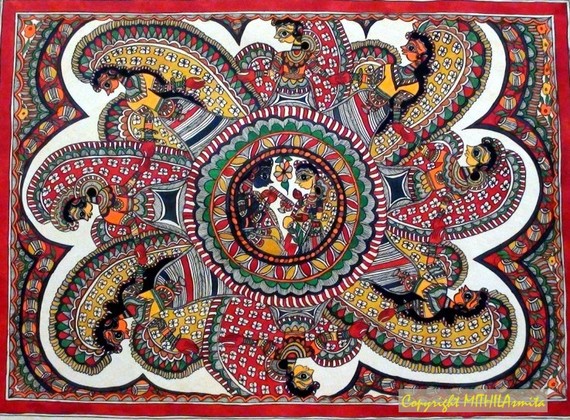Through my lenses for traditional art, I have been researching how regional art forms have emerged over centuries and how undiscovered talents in remote villages do extraordinary creativity in their native art form.
The native art forms are the expressions and the language of ‘not so formally literate’ brethren of this world. They may not be able to narrate a story in the international languages of the world, but they can paint the entire story through their rustic brushes. Such is the talent of traditional master artists!
They may not be able to narrate a story in the international languages of the world, but they can paint the entire story through their rustic brushes.
Very few know that such traditional art forms are much evolved ones, with huge variation in styles, themes and color patterns from one artist to another.
The art originally existed to bind the society together and make it culturally rich.
Numerous products are available in the market today, hand painted or even printed with this colorful, vibrant art. And such randomly available hand made products give an expression that the art just belongs to the handicrafts category.
The Indian Government commercialized the Mithila art during 1960s to combat the infamous drought in Bihar. The calamity had crippled the agriculture industry of the state.
However, despite the organized commercialization, the rural folks were unable to make their ends meet. Also with the growing unfair practices of producing art quickly only to sell, very few artists remained who still practiced the art for the love of it.
The real creativity flows when an artist paints for her love of art!
Sita Devi played with colors like none else could. The effervescence that she brought in her art work by the long and pointed features of human figures besides, the vibrant and bold choice of her palette were unparalleled. She was honored with the highest civilian award, Padma Shri for her enchanting Mithila Paintings. Late Indian Prime Minister Mrs. Indira Gandhi too patronized her art.

Ganga Devi belonged to the Kayastha Community, who practiced line art of Mithila to narrate multiple stories from Hindu mythologies, Ramayana and Mahabharata. The fineness of the lines in her paintings and the symmetries in her work could lead any seasoned art connoisseur mistake them for prints.
She even painted her own life tales through art, including her battle with cancer.
Her paintings sold for millions of Indian Rupees in the later part of her life. Many of those are still exhibited at Mithila Museum, Japan.
Lalita Devi loves narrating stories from Maithil traditions, fables and religious scriptures through her art. She has been practicing Madhubani Paintings for the past five decades, and almost every time paints a new theme, a new story, a new poem. A great Krishna fan, she loves narrating (17th century poet) Vidyapati’s poems on Krishna, through her art.
Most of the traditional artists were very educated in religious scriptures, folk tales but not in modern day education. So, many of these legendary artists could not even sign their names well. However, their art would have something inspired from their own personality to act like a signature. Lalita Devi makes eyes, the most adorable part of her creations. The human figures in her artworks have long slender eyes inspired by her own!
Their art would have something inspired from their own personality to act like a signature.
Lalita Devi, just like Sita Devi and Ganga Devi, mentored several budding artists. Upcoming master artists like Narmada Devi and Sunita Devi are her disciples too. And just like other masters, they too have started developing their own styles.
Eventually, Madhubani painting grew beyond just a tradition and gave international identity to many masters. Many master Mithila artists were awarded with the highest Indian Civilian Award like Padma Shri and National awards for their extraordinary creativity with the Mithila Art. Some even traveled internationally to exhibit their work in different corners of the world. Several of these master paintings, even today, feature in international museums around the globe.
Such masters are institutions in themselves. They have their own unique styles which very few can imitate. Undoubtedly, there are imitations in the market or works inspired by these masters. Nevertheless, a connoisseur can almost always tell the difference between an original and an imitation.
Scores of master Mithila Painting artists were awarded with highest Indian Civilian Award like Padma Shri and National awards for their extraordinary creativity with the Madhubani Art.
Today, most of such traditional paintings are available as prints or lifeless mass produced handicrafts, sold cheaply in the market.
These master artists don’t create commercial products, they create legacies through their drawings which is beyond gender, beyond region, beyond beliefs!
On the other hand, the master artists don’t create commercial products. They create legacies through their drawings which are beyond gender, beyond region, beyond beliefs! Such master artists don’t deserve their art to be sold cheaply in the market, as just another handicraft. Rather, their paintings deserve walls in the most prestigious museums of the world and the right coronation for the art form itself.
Many more Lalita Devis, Sita Devis and Ganga Devis are waiting to be discovered and it will happen only if traditional art forms get the patronage of the world and the livelihoods of the traditional artists do not remain a challenge!
Originally published in Huffington Post /




